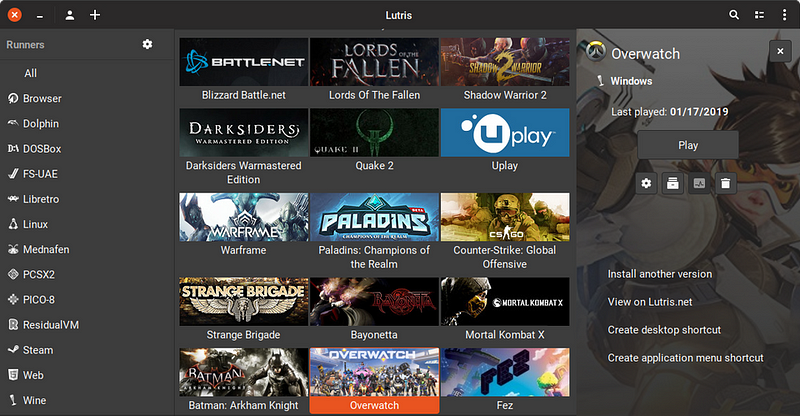6 Months Without Windows: The Ugly Truth About Gaming On Linux

UPDATE May 2019: I’ve taken your comments to heart. Based on your feedback, I’ve started a comprehensive Linux Gaming Report at Forbes. It analyzes the setup and overall ease-of-use across 9 popular distros.
I’ve been striving to exclusively use desktop Linux for the past six months, and I’m not leaving it any time soon. The experience has been transformative, educational and downright fun at times. There’s always this air of excitement surrounding every challenge that gets conquered or every new discovery made. Most importantly, my Personal Computer truly feels personal again, and that comes with the freedom and satisfaction of using open source software to get the majority of my work done. The ability to customize my operating system any way I see fit, tailored to any need.
But lest you think it’s all a sugar-coated, headache-free computing utopia, I’m here to remind you that while I consider myself a Linux advocate, I’m also a critic.
Gaming On Linux: Better Than Ever, But Never Up To Date
I’ve written repeatedly about Valve’s Proton initiative at Forbes. This lets Steam gamers on Linux play literally thousands of Windows-exclusive games without any kind of obscure setup or file tweaking. A week after it launched, more than 1000 of those Windows games were perfectly playable. Several months later it has ballooned to more than 4000 according to protondb.com.
Then there’s Lutris, which does a lot of the heavy lifting and configuring, letting you install clients like EA’s Origin and play those games with a few clicks.
The problem isn’t the availability of games.
The problem is the complete fragmentation and confusion when it comes to graphics drivers.
The Nvidia Puzzle
In the Linux world, there are proprietary and open source drivers for both AMD and Nvidia graphics cards, and those are included right in the kernel. But if you’re rocking an Nvidia GTX card, the open source “Nouveau” drivers are disappointing.
Don’t believe me? Have a look at these benchmark comparisons published by Phoronix. This is an extreme example, but still representative of the problem. In several games, proprietary drivers will offer at least 70% higher framerates.

While I admire the work developers are doing to create open source driver solutions, no gamer in their right mind would want to use Nouveau instead of Nvidia’s proprietary driver. And Nouveau doesn’t have Vulkan support, which rules out a considerable number of games with Steam Proton and Lutris.
This means Nvidia gamers need to install the proprietary driver. Fortunately, Linux distributions like Pop!_OS, Deepin and Mint made this a straightforward process. But is it?
Using Ubuntu 18.10 as an example, users just need to go “Software & Updates” and click on “Additional Drivers.” There you’ll see an option to install the Nvidia Driver metapackage, labeled as nvidia-driver-390. Select it, click apply, and you’re no longer using that subpar open source driver.
But here’s the first problem: is this all common knowledge for new users? I’m willing to bet it is not. Even if they’ve been told the differences between open source and proprietary drivers, what happens when they do navigate to this area of Ubuntu and update? Maybe they’ll be eager to check out what all this fuss is about Steam Proton and playing their favorite Windows games on Linux.
Not so fast.
Valve lists the graphic driver requirements for Proton as Nvidia 415, which is several months newer than Nvidia 390. Now users will need to add a “PPA” which is a software repository not built in to Ubuntu. Will that have the right driver? How do they know without extensive googling? Is that going to update automatically, and as often as Nvidia’s Windows 10 drivers do?
The AMD Problem

Confusingly, the situation with Radeon drivers is completely different. In the majority of cases, the open source “MESA” drivers offer slightly better gaming performance than AMD’s proprietary ones. Linux users have less of a maze to navigate there since these are built in and will update automatically. But are they updating fast enough?
Well, if you have a Radeon VII or even Vega 56/64, probably not. You’ll need to add a “PPA” (that stands for personal package archive) to get the latest open source driver that best supports it. But which PPA? This one? This one? Is Vulkan included? Will the latest version of Ubuntu include that or not? What the heck is stable vs unstable? Is that dangerous for my system?
Who is Paulo Diaz and can I trust that guy?
Now, I am not most mainstream gamers nor PC users. For as user-friendly as Linux has become, gaming still requires some guesswork, which I’ve only navigated by completely immersing myself in it. And the direction changes dramatically based on if you’re using Team Red or Team Green. It changes based on what flavor of Linux you’re using.
Here’s the bottom line, and I hope that everyone involved in the development of every single Linux distributions hears this: It’s still far too complicated for the average user. The education is lacking and the documentation that’s out there is often difficult to understand.
I want the gaming ecosystem on Linux to continue improving — and it’s truly fantastic once you have it all figured out — but there is still serious work to do to appeal to all those folks becoming disenchanted with Windows 10.
It all just needs to be simpler.
Talk to me on Twitter | Listen to my Linux Podcast | Read my new website

📝 Read this story later in Journal.
👩💻 Wake up every Sunday morning to the week’s most noteworthy stories in Tech waiting in your inbox. Read the Noteworthy in Tech newsletter.


Member discussion